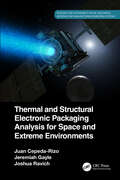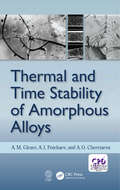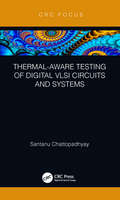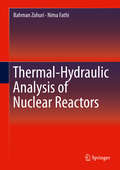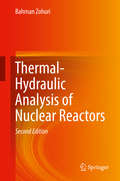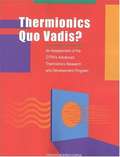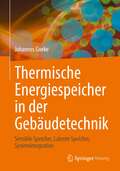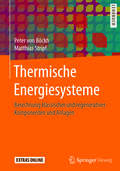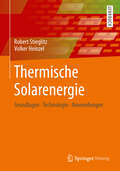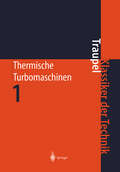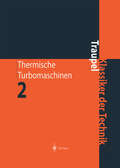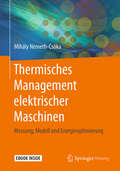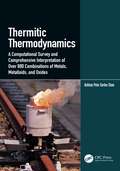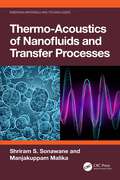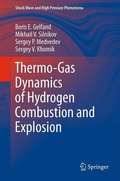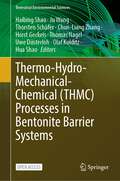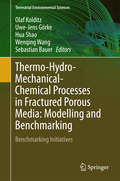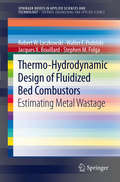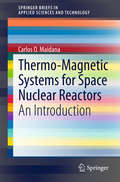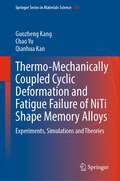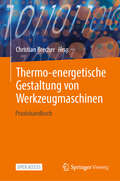- Table View
- List View
Thermal and Structural Electronic Packaging Analysis for Space and Extreme Environments (Resilience and Sustainability in Civil, Mechanical, Aerospace and Manufacturing Engineering Systems)
by Juan Cepeda-Rizo Jeremiah Gayle Joshua RavichHave you ever wondered how NASA designs, builds, and tests spacecrafts and hardware for space? How is it that wildly successful programs such as the Mars Exploration Rovers could produce a rover that lasted over ten times the expected prime mission duration? Or build a spacecraft designed to visit two orbiting destinations and last over 10 years when the fuel ran out? This book was written by NASA/JPL engineers with experience across multiple projects, including the Mars rovers, Mars helicopter, and Dawn ion propulsion spacecraft in addition to many more missions and technology demonstration programs. It provides useful and practical approaches to solving the most complex thermal-structural problems ever attempted for design spacecraft to survive the severe cold of deep space, as well as the unforgiving temperature swings on the surface of Mars. This is done without losing sight of the fundamental and classical theories of thermodynamics and structural mechanics that paved the way to more pragmatic and applied methods such finite element analysis and Monte Carlo ray tracing, for example. Features: Includes case studies from NASA’s Jet Propulsion Laboratory, which prides itself in robotic exploration of the solar system, as well as flyting the first cubeSAT to Mars. Enables spacecraft designer engineers to create a design that is structurally and thermally sound, and reliable, in the quickest time afforded. Examines innovative low-cost thermal and power systems. Explains how to design to survive rocket launch, the surfaces of Mars and Venus. Suitable for practicing professionals as well as upper-level students in the areas of aerospace, mechanical, thermal, electrical, and systems engineering, Thermal and Structural Electronic Packaging Analysis for Space and Extreme Environments provides cutting-edge information on how to design, and analyze, and test in the fast-paced and low-cost small satellite environment and learn techniques to reduce the design and test cycles without compromising reliability. It serves both as a reference and a training manual for designing satellites to withstand the structural and thermal challenges of extreme environments in outer space.
Thermal and Time Stability of Amorphous Alloys
by A. Glezer A. Potekaev A. CheretaevaThis reference is dedicated to the problem of time-temperature stability of amorphous (non-crystalline) metal alloys with strongly nonequilibrium structure and unique physical and mechanical properties that are obtained by quenching from the melt at a rate that exceeds one millions of degrees c.o.s. second. As a stability test, the behavior of the plasticity of amorphous alloys is studied. The book examines the fundamental characteristics of amorphous alloys, the basic laws of structural relaxation, generalized information about the phenomenon of the ductile-brittle transition (temper embrittlement), the development of physically justified methods of predicting the stability of the properties, and provides information about the attempts of controlling the structure for the purpose of suppressing or deceleration of the ductile-brittle transition and, as a consequence, increasing the temperature and temporal stability of the amorphous state.
Thermal-Aware Testing of Digital VLSI Circuits and Systems
by Santanu ChattopadhyayThis book aims to highlight the research activities in the domain of thermal-aware testing. Thermal-aware testing can be employed both at circuit level and at system level Describes range of algorithms for addressing thermal-aware test issue, presents comparison of temperature reduction with power-aware techniques and include results on benchmark circuits and systems for different techniques This book will be suitable for researchers working on power- and thermal-aware design and the testing of digital VLSI chips
Thermal-Hydraulic Analysis of Nuclear Reactors
by Bahman Zohuri Nima FathiThis text covers the fundamentals of thermodynamics required to understand electrical power generation systems and the application of these principles to nuclear reactor power plant systems. It is not a traditional general thermodynamics text, per se, but a practical thermodynamics volume intended to explain the fundamentals and apply them to the challenges facing actual nuclear power plants systems, where thermal hydraulics comes to play. Written in a lucid, straight-forward style while retaining scientific rigor, the content is accessible to upper division undergraduate students and aimed at practicing engineers in nuclear power facilities and engineering scientists and technicians in industry, academic research groups, and national laboratories. The book is also a valuable resource for students and faculty in various engineering programs concerned with nuclear reactors. This book also: Provides extensive coverage of thermal hydraulics with thermodynamics in nuclear reactors, beginning with fundamental definitions of units and dimensions, thermodynamic variables, and the Laws of Thermodynamics progressing to sections on specific applications of the Brayton and Rankine cycles for power generation and projected reactor systems design issues Reinforces fundamentals of fluid dynamics and heat transfer; thermal and hydraulic analysis of nuclear reactors, two-phase flow and boiling, compressible flow, stress analysis, and energy conversion methods Includes detailed appendices that cover metric and English system units and conversions, detailed steam and gas tables, heat transfer properties, and nuclear reactor system descriptions
Thermal-Hydraulic Analysis of Nuclear Reactors
by Bahman ZohuriThis text covers the fundamentals of thermodynamics required to understand electrical power generation systems and the application of these principles to nuclear reactor power plant systems. It is not a traditional general thermodynamics text, per se, but a practical thermodynamics volume intended to explain the fundamentals and apply them to the challenges facing actual nuclear power plants systems, where thermal hydraulics comes to play. Written in a lucid, straight-forward style while retaining scientific rigor, the content is accessible to upper division undergraduate students and aimed at practicing engineers in nuclear power facilities and engineering scientists and technicians in industry, academic research groups, and national laboratories. The book is also a valuable resource for students and faculty in various engineering programs concerned with nuclear reactors. This book also: Provides extensive coverage of thermal hydraulics with thermodynamics in nuclear reactors, beginning with fundamental definitions of units and dimensions, thermodynamic variables, and the Laws of Thermodynamics progressing to sections on specific applications of the Brayton and Rankine cycles for power generation and projected reactor systems design issues Reinforces fundamentals of fluid dynamics and heat transfer; thermal and hydraulic analysis of nuclear reactors, two-phase flow and boiling, compressible flow, stress analysis, and energy conversion methods Includes detailed appendices that cover metric and English system units and conversions, detailed steam and gas tables, heat transfer properties, and nuclear reactor system descriptions
Thermally Stable and Flame Retardant Polymer Nanocomposites
by Vikas MittalPolymer nanocomposites have revolutionised material performance, most notably in the plastics, automotive and aerospace industries. However, in order to be commercially viable, many of these materials must withstand high temperatures. In this book, leaders in the field outline the mechanisms behind the generation of suitable polymer systems, pulling together recent research to provide a unified and up-to-date assessment of recent technological advancements. The text is divided into two clear sections, introducing the reader to the two most important requirements for this material type: thermal stability and flame retardancy. Special attention is paid to practical examples, walking the reader through the numerous commercial applications of thermally stable and flame retardant nanocomposites. With a strong focus on placing theory within commercial context, this unique volume will appeal to practitioners as well as researchers.
Thermionics Quo Vadis?: An Assessment of the DTRA's Advanced Thermionics Research and Development Program
by Technology Committee on Thermionic ResearchThis report evaluates the Defense Threat Reduction Agency prior and present sponsored efforts; assess the present state of the art in thermionic energy conversion systems; assess the technical challenges to the development of viable thermionic energy conversion systems for both space and terrestrial applications; and recommend a prioritized set of objectives for a future research and development program for advanced thermionic systems for space and terrestrial applications.
Thermische Energiespeicher in der Gebäudetechnik: Sensible Speicher, Latente Speicher, Systemintegration
by Johannes GoekeDie Speicherung von thermischer Energie in Form von Wärme und Kälte steht im Mittelpunkt dieses Buches. Inhalt sind die Themenbereiche wassergefüllte Speicher mit sensibler Wärme, latente Wärme-/Kältespeicher mit Phasenwechsel-Materialien sowie das Gebäude als thermischer Speicher. Dazu kommen Anwendungen im Bereich der Gebäude und Quartiere. Dabei liegt der Focus immer wieder auf der Belade- und Entladedynamik der unterschiedlichen Speichertypen.
Thermische Energiesysteme: Berechnung klassischer und regenerativer Komponenten und Anlagen
by Peter Von Böckh Matthias StripfDas Buch behandelt alle wesentlichen Aspekte zur grundlegenden Berechnung thermischer Energiesysteme. Es versetzt Studierende und Ingenieure in die Lage, reale Komponenten und Systeme tats#65533;chlich zu berechnen und zu konstruieren und ist damit eine ideale Fortsetzung der grundlagenorientierten B#65533;cher zur Thermodynamik, Fluidmechanik und W#65533;rme#65533;bertragung. Neben den klassischen Komponenten und Anlagen zur Energieversorgung werden auch die an Bedeutung gewinnenden Technologien, wie Windkraftanlagen und W#65533;rmepumpen im Detail behandelt. Alle Beispiele sind als Mathcad-Programme im Internet herunterladbar, ebenso wichtige Diagramme und Programme zur Berechnung der Stoffwerte. Die Zielgruppen - Studierende des Maschinenbaus und der Verfahrenstechnik - Planer und Entwickler im Bereich Thermische Energiesysteme
Thermische Solarenergie
by Robert Stieglitz Volker HeinzelVon der physikalischen Basis bis zu Umsetzungen im häuslichen und kraftwerkstechnischen Bereich reichen die Aspekte der Solarthermie. Dieses Buch bietet eine fundierte Analyse der Thematik von Grundlagen der solaren Einstrahlung bis zu neuen Anwendungen. Diskutiert werden passive Aspekte, Energie- und Impulstransport in Systemen, aktive Nutzung von Niedertemperatursystemen sowie kraftwerkstechnische Umsetzungen. Bisher genutzte Konzepte, Spezifika und die Ankopplung an Kraftwerkszyklen werden ebenso beschrieben wie potenzielle Speicherverfahren.
Thermische Turbomaschinen
by Walter TraupelDas Werk gibt eine umfassende Darstellung der theoretischen Grundlagen zur Berechnung und Auslegung von Dampfturbinen, Gasturbinen und Turbokompressoren. Der erste Band behandelt die thermodynamische Prozeßführung von Dampf- und Gasturbinenanlagen und die thermodynamisch-strömungstechnische Berechnung der Turbomaschinen selbst. Um zu einem vertieften Verständnis zu führen, wird die Theorie stets aus den Grundwissenschaften heraus entwickelt, weshalb auch ein kurzer Abriß der thermodynamischen und strömungstechnischen Grundlagen an den Anfang gestellt ist.
Thermische Turbomaschinen: Geänderte Betriebsbedingungen, Regelung, Mechanische Probleme, Temperaturprobleme
by Walter TraupelDas Buch behandelt ausführlich das Verhalten der thermischen Turbomaschinen unter geänderten Betriebsbedingungen und darauf aufbauend ihre Regelungseigenschaften. Weiter werden die spezifischen Festigkeitsprobleme der Turbomaschinen dargestellt. Diesen Kapiteln ist ein allgemeines Kapitel über die Grundlagen der Festigkeitsrechnungen vorausgeschickt, das zwar diejenigen Aspekte besonders hervorhebt, die im Turbomaschinenbau vor allem wichtig sind, aber auch für verwandte Gebiete bedeutsam ist, da eine geraffte Darstellung dieser Art bis heute fehlt. Der Bestimmung der Temperaturverteilung in den maßgebenden Konstruktionsteilen (insbes. in der gekühlten Gasturbine) ist ein weiteres Kapitel gewidmet. Den Abschluß bilden die Ausführungen über die Schaufelschwingungen und die lauftechnischen Probleme der Rotoren.
Thermisches Management elektrischer Maschinen
by Mihály Németh-CsókaDas Buch fasst den aktuellen Stand der wichtigsten thermischen Aspekte einer umrichtergespeisten elektrischen Maschine zusammen. Neben den typischen Themen wie Modellierung, Wirkungsgradoptimierung oder Widerstandadaption werden auch Bestimmung von Zeitkonstanten, Temperaturmessung, kT-Adaption, Entmagnetisierung und Alterung der Isolation beschrieben.Schwerpunkte sind praktische Anwendungsmöglichkeiten in Echtzeitsystemen bei der Modellierung und bei der Wirkungsgradoptimierung. Das Buch eignet sich besonders für den Ingenieur mit industrieller Praxis oder als Lehrbuch für Studenten, die sich vertiefend mit elektrischen Antrieben beschäftigen.
Thermitic Thermodynamics: A Computational Survey and Comprehensive Interpretation of Over 800 Combinations of Metals, Metalloids, and Oxides
by Anthony Peter ShawThermites, which are generally considered to be reactive mixtures of powdered metals and metal oxides, are an important subset of energetic materials. The underlying thermodynamic properties of a given mixture dictate whether it may undergo a self-sustaining reaction, liberating heat in the process. Thermodynamic information in the existing scientific literature regarding thermitic combinations is scattered and incomplete. Currently, a comprehensive overview of this nature would be of great use to those working in the areas of pyrotechnics, pyrometallurgy, high-temperature chemistry, and materials science. Thermitic Thermodynamics solves this problem by describing the results of calculations on over 800 combinations of metal, metalloid, and metal oxide reactants.Other features include: A first-of-its-kind adiabatic survey of binary thermitic reactions Provides an overview of key trends in exothermic metal-metal oxide reactivity Describes the role of non-oxide product formation in thermitic systems Explains how to interpret the results of thermochemical calculations effectively An invaluable resource, this book provides an accessible introduction for students and is also an enduring guide for professionals.
Thermo-Acoustics of Nanofluids and Transfer Processes (Emerging Materials and Technologies)
by Shriram S. Sonawane Manjakuppam MalikaThis book explains the physical principles and theoretical basis of acoustics of nanofluids with mathematical rigor, focusing on concepts and points of view that have proven effective in applications such as heat transfer, petroleum science and technology, wastewater treatment, food processing, and hydrogen production. It provides a rigorous framework to aid readers in building innovative nanofluid-based devices, covering essential topics such as the study and measurement of thermophysical characteristics, convection, and heat transfer equipment performance.Features: Focuses on the basics of nanofluids, shedding light on the thermo-acoustic behavior Discusses the specific needs of a nanofluid for a process in terms of both heat and mass transfer Discusses the process transfer of nanofluids with reference to thermo-acoustics Discusses the numerical and experimental investigations of nanofluids used in various fields of industrial applications Reviews fundamentals and applied aspects of acoustic cavitation This book is aimed at graduate students and researchers in fluid dynamics, nanotechnology, and chemical and mechanical engineering.
Thermo-Gas Dynamics of Hydrogen Combustion and Explosion
by Boris E. Gelfand Mikhail V. Silnikov Sergey P. Medvedev Sergey V. KhomikThe potential of hydrogen as an important future energy source has generated fresh interest in the study of hydrogenous gas mixtures. Indeed, both its high caloricity and reactivity are unique properties, the latter underscoring safety considerations when handling such mixtures. The present monograph is devoted to the various aspects of hydrogen combustion and explosion processes. In addition to theoretical and phenomenological considerations, this work also collates the results of many experiments from less well known sources. The text reviews the literature in this respect, thereby providing valuable information about the thermo-gas-dynamical parameters of combustion processes for selected experimental settings in a range of scientific and industrial applications.
Thermo-Gas Dynamics of Hydrogen Combustion and Explosion (Shock Wave and High Pressure Phenomena)
by Boris E. Gelfand Mikhail V. Silnikov Sergey P. Medvedev Sergey V. KhomikThe potential of hydrogen as an important future energy source has generated fresh interest in the study of hydrogenous gas mixtures. Indeed, both its high caloricity and reactivity are unique properties, the latter underscoring safety considerations when handling such mixtures. The present monograph is devoted to the various aspects of hydrogen combustion and explosion processes. In addition to theoretical and phenomenological considerations, this work also collates the results of many experiments from less well known sources. The text reviews the literature in this respect, thereby providing valuable information about the thermo-gas-dynamical parameters of combustion processes for selected experimental settings in a range of scientific and industrial applications.
Thermo-Hydraulics of Nuclear Reactors
by Christopher Earls BrennenThis book provides a concise and up-to-date summary of the essential thermo-hydraulic analyses and design principles of nuclear reactors for electricity generation. Beginning with the basic nuclear physics, it leads through technical and quantitative analyses to descriptions of both the normal operation of the various modern nuclear reactor designs and the analyses of the possible departures from normal operation. It then describes both the postulated accident scenarios and summaries of the causes for the three major nuclear power generation accidents, Three Mile Island, Chernobyl and Fukushima as well as the major improvements to reactor safety that grew out of those analyses and accidents.
Thermo-Hydro-Mechanical-Chemical (Terrestrial Environmental Sciences)
by Thomas Nagel Olaf Kolditz Hua Shao Haibing Shao Ju Wang Thorsten Schäfer Chun-Liang Zhang Horst Geckeis Uwe DüsterlohThis book is open access book. The collaborative Pilot Project, titled “Comparison of Thermo-Hydro-Mechanical-Chemical (THMC) Processes in Bentonite Barrier Systems”, aims to investigate the fundamentals, conduct laboratory and field experiments, and develop numerical models for barrier systems that ensure the safe isolation of radioactive waste in deep geological repositories. This book compares methodologies and technologies used in experimental laboratory and field research, as well as systems analysis, in a collaborative work of German and Chinese scientists. Both parties have access to exceptional experimental and modelling research capabilities. The Beishan underground research laboratory (URL) is currently under construction in Gansu, China. It will serve as an international collaboration platform for URL research in the future. International cooperation is essential for excellent research and development due to the high cost of scientific programmes and technical operation of URLs, making it a precondition for providing secure solutions. This is important not only for deep geological repositories for radioactive waste disposal but also for other geoenergy applications, such as energy storage and geothermal energy utilization.
Thermo-Hydro-Mechanical-Chemical Processes in Fractured Porous Media: Modelling and Benchmarking
by Uwe-Jens Görke Olaf Kolditz Hua Shao Wenqing Wang Sebastian BauerThis book presents a new suite of benchmarks for and examples of porous media mechanics collected over the last two years. It continues the assembly of benchmarks and examples for porous media mechanics published in 2014. The book covers various applications in the geosciences, geotechnics, geothermal energy, and geological waste deposition. The analysis of thermo-hydro-mechanical-chemical (THMC) processes is essential to many applications in environmental engineering, such as geological waste deposition, geothermal energy utilisation, carbon capture and storage, water resources management, hydrology, and even climate change. In order to assess the feasibility and safety of geotechnical applications, process-based modelling is the only tool that can effectively quantify future scenarios, a fact which also creates a huge burden of responsibility concerning the reliability of computational tools. The book shows that benchmarking offers a suitable methodology for verifying the quality of modelling tools based on best practices, and together with code comparison fosters community efforts. It also provides a brief introduction to the DECOVALEX, SeSBench and MOMAS initiatives. This benchmark book is part of the OpenGeoSys initiative - an open source project designed to share knowledge and experience in environmental analysis and scientific computation.
Thermo-Hydrodynamic Design of Fluidized Bed Combustors
by Stephen M. Folga Walter F. Podolski Jacques X. Bouillard Robert W. LyczkowskiThermo-Hydrodynamic Design of Fluidized Bed Combustors: Estimating Metal Wastage is a unique volume that finds that the most sensitive parameters affecting metal wastage are superficial fluidizing velocity, particle diameter, and particle sphericity. Gross consistencies between disparate data sources using different techniques were found when the erosion rates are compared on the same basis using the concept of renormalization. The simplified mechanistic models and correlations, when validated, can be used to renormalize any experimental data so they can be compared on a consistent basis using a master equation.
Thermo-Magnetic Systems for Space Nuclear Reactors
by Carlos O. MaidanaIntroduces the reader to engineering magnetohydrodynamics applications and presents a comprehensive guide of how to approach different problems found in this multidisciplinary field. An introduction to engineering magnetohydrodynamics, this brief focuses heavily on the design of thermo-magnetic systems for liquid metals, with emphasis on the design of electromagnetic annular linear induction pumps for space nuclear reactors. Alloy systems that are liquid at room temperature have a high degree of thermal conductivity far superior to ordinary non-metallic liquids. This results in their use for specific heat conducting and dissipation applications. For example, liquid metal-cooled reactors are typically very compact and can be used in space propulsion systems and in fission reactors for planetary exploration. Computer aided engineering (CAE), computational physics and mathematical methods are introduced, as well as manufacturing and testing procedures. An overview on space nuclear systems is also included. This brief is an invaluable tool for design engineers and applied physicists as well as to graduate students in nuclear and mechanical engineering or in applied physics.
Thermo-Mechanically Coupled Cyclic Deformation and Fatigue Failure of NiTi Shape Memory Alloys: Experiments, Simulations and Theories (Springer Series in Materials Science #335)
by Guozheng Kang Qianhua Kan Chao YuWritten by leading experts in the field, this book highlights an authoritative and comprehensive introduction to thermo-mechanically coupled cyclic deformation and fatigue failure of shape memory alloys. The book deals with: (1) experimental observations on the cyclic deformation and fatigue failure in the macroscopic and microscopic scales; (2) molecular dynamics and phase-field simulations for the thermo-mechanical behaviors and underlying mechanisms during cyclic deformation; (3) macroscopic phenomenological and crystal plasticity-based cyclic constitutive models; and (4) fatigue failure models. This book is an important reference for students, practicing engineers and researchers who study shape memory alloys in the areas of mechanical, civil and aerospace engineering as well as materials science.
Thermo-Poroelasticity and Geomechanics
by Selvadurai A. P. S. Suvorov A. P.Investigations of multi-physical processes in geomaterials have gained increasing attention due to the ongoing interest in solving complex geoenvironmental problems. This book provides a comprehensive exposition of the classical theory of thermo-poroelasticity, complemented by complete examples to problems in thermo-poromechanics that are used to validate computational results from multi-physics codes used in practice. The methodologies offer an insight into real-life problems related to modern environmental geosciences, including nuclear waste management, geologic sequestration of greenhouse gases to mitigate climate change, and the impact of energy resources recovery on groundwater resources. A strong focus is placed on analytical approaches to benchmark the accuracy of the computational approaches that are ultimately used in real-life problems. The extensive coverage of both theory and applications in thermo-poroelasticity and geomechanics provides a unified presentation of the topics, making this an accessible and invaluable resource for researchers, students or practitioners in the field.
Thermo-energetische Gestaltung von Werkzeugmaschinen: Praxishandbuch
by Christian BrecherThermo-energetische Gestaltung von Werkzeugmaschinen Dieses Buch beschreibt Maßnahmen zur Sicherstellung der Bearbeitungsgenauigkeit unter thermisch instationären Bedingungen bei gesteigerter Produktivität, ohne zusätzliche Energie für die Temperierung aufzuwenden. Es werden Forschungsergebnisse zu thermischen Einflüssen sowie deren Beeinflussung und Beherrschung vorgestellt. Die dargestellten Entwicklungsarbeiten wurden im Rahmen des Sonderforschungsbereich/Transregio 96 (SFB/TR 96) von der DFG gefördert und umfassen die Weiterentwicklung von Modellgrundlagen, Kompensationsmaßnahmen und steuerungsintegrierte Korrekturverfahren. Im Bereich der Modellgrundlagen werden die Modellierung von Baugruppen und Gesamtmaschinen, die Verhaltensanalyse, die Parametrierung und effizienzsteigernde Berechnungsmethoden behandelt. Die Kompensationsmaßnahmen umfassen Fluidkreisläufe und die aktive Steuerung von Wärmeflüssen. Die steuerungsintegrierten Korrekturverfahren beinhalten sowohl modellbasierte als auch messtechnisch basierte Ansätze. Zusätzlich werden die entwickelten Lösungsverfahren und Ergebnisse aus der praktischen Erprobung an Baugruppen und Gesamtmaschinen bewertet. Das Open-Access-Buch richtet sich an Praktiker aus dem Bereich des Werkzeugmaschinenbaus.
